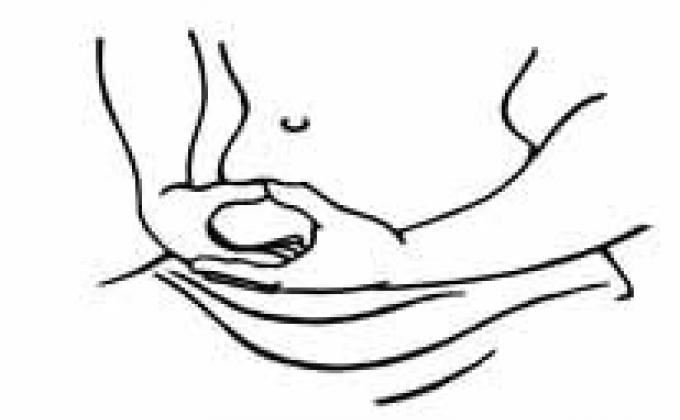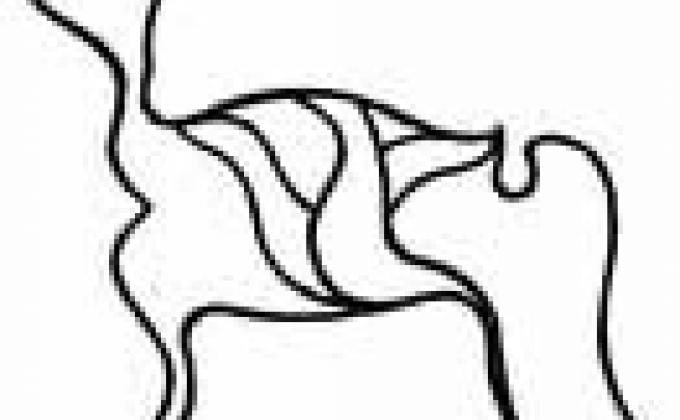
Arms crossed, legs resting on hips, gaze at the tip of the nose, tongue pressed to the roots of the teeth. The chin is raised, the chest is expanded. Inhaling air slowly, fill your chest and exhale in a slow, continuous stream.
Not everyone, but only the wise achieves success in this. He balances his life forces, which now flow harmoniously through his entire body.
Pranayama in padmasana brings the yogi, who knows the action of prana, to Liberation. "" Shiva Samhita "(3.88 - 91)
Seven principles for the lotus pose
(seven-membered lotus pose)
- Legs
You sit with your legs crossed in a full lotus with each foot with the heel up and resting on the thigh of the other leg. A small firm pillow should be placed under the buttocks, then the legs will not swell.
You can sit in a full lotus if the muscles are elastic and the joints are developed, that is, if it is comfortable. If it is impossible to immediately sit in the full lotus position, the yogi should choose siddhasana or cross-legged position (sukhasana).
2. Hands
Hands should be relaxed, put one palm on top of the other below the navel. The palms are facing up. The right palm rests on the left, the fingers are parallel. The palms are fully open. The tips of the thumbs come together to form a straight line, so that the palms slightly resemble a bowl. The shoulders and arms are relaxed. Hands are located at a distance of 5-8 cm from the abdomen.
3. Back
The spine should be made straight, the back muscles should be relaxed, the back of the head should be slightly pulled up, as if the spine was suspended from the back of the head.
4. Eyes
The eyes should be kept half-closed so that the light shines a little through the eyelids and eyelashes. The gaze is directed in front of you, to the floor. If the beginner closes his eyes completely, blurring occurs (immersion in internal visions or sleep).
5. Jaw
The jaw is relaxed, the teeth do not touch each other, but the lips are pressed against each other.
6. Language
To close and circulate energy in the body, the tip of the tongue should be pressed against the upper palate at one of four points:
at the upper teeth (jihva mudra),
in the middle of the palate (nabho mudra),
closer to the small tongue (manduki mudra),
wrapped in a hole behind the small tongue (khechari mudra).
7. Head
The neck is tilted slightly forward so that the gaze is naturally directed in front of you and slightly down. If the head falls on the chest, drowsiness and inertia occur. If you raise your head high, excitement and movement of thoughts will increase.
Siddhasana
"Shiva taught eighty-four asanas ... of which the most comfortable and best is siddhasana.
Press the heel of one leg to the perineum, place the foot of the other leg above the genitals, then lower the chin to the chest, staying in serenity and controlling the senses, continuously concentrating at the point between the eyebrows. This opens the door to Liberation. This posture is called siddhasana. "
Hatha Yoga Pradipika (1.35 - 36)
You should sit down, pressing the heel of your left leg to the perineum, the point between the anus and the genitals. The right foot should be pressed so that the heel touches the pubis, just above the genitals. Then place the toes and the end of the right foot between the gastrocnemius muscle and the left thigh muscle, pushing them through. When you have taken this position, you should relax by dropping your chin and straightening your back. Sitting in this way, the yogi concentrates on the point between the eyebrows.
When the yogi sits in siddhasana, the mooladhara chakra is stimulated, and the winds begin to rise from it, constantly clearing the nadis and removing blockages in them.
Hand position (mudra)
Thanks to the special arrangement of the hands (mudra), you can activate certain elements in your body, balance the winds.
Jnana mudra
The yogi sits in padmasana or siddhasana with his palms on his knees. The hands are positioned as follows: the index fingers touch the tips of the thumbs, the rest of the fingers are free.
When the palms are facing up, this indicates that we are inviting the energies of divine beings to enter our body.
Chin-mudra
The index fingers touch the base of the thumbs, the rest of the fingers are on the knees as usual.
Skillful posture is the vital quality of yoga meditation.
Sit on a rug or soft seat, feet in lotus position or, if difficult, in sukhasana
Hands in contemplation position: at the abdomen and about five centimeters below the navel, the back of the right palm is placed on the open palm of the left hand, two thumbs are raised up, touching each other
The back is straightened, the spine is vertical so that it stiffens the whole body
Hands at the elbows are straightened from below to the shoulders, do not bend
The chin is pressed slightly down so that the neck is slightly tilted
The tip of the tongue touches the upper palate, while the teeth barely touch, the lips are slightly closed
The eyes calmly gaze into space a little further than the tip of the nose, the eyeballs are motionless
Others teach that lips and teeth should be in a more natural position, but for beginners, the mentioned position is better.
The eighth aspect is breathing in meditation. While meditating, breathe in and out gently, without effort, without even feeling it. One should not puff, one should not breathe heavily or with tension.
"Practice The gi should keep his heart restrained by sitting upright in the asana with the legs bent, keeping the body straight and the hips completely flat (horizontal) in front of you, without touching the genitals and lifting the head slightly so that it faces straight ahead.
He should not touch his teeth with his teeth. Not paying attention to anything around, he should concentrate on the "tip of the nose" (one should learn personally from the Guru what "tip of the nose" means and where it is located).
At this time, the yogi, who has become entrenched in pure essence, having conquered the tamasic qualities of the rajasic and the rajasic sattvic, should achieve a still state of breathing or calm breathing. By isolating his mind and prana from the object of concentration with a balanced state (calm breathing), he should do pratyahara, self-absorption.
He should focus only on the Atma (Atman), "I", observing his "I", curbing his kama (attachment, attention to the outside) and krodha (anger), like a turtle drawing in its senses. Having cleared himself internally and externally from the throat to the navel, he should practice pratyahara, self-absorption, filling the body.
Thus, restrained, the yogi becomes free from all impurities. An endless world arises in it. He achieves the ability to see the qualities of nature and the higher self.
Avadhuta Dattatreya, "Yoga Rahasya" (29-36)
"Keep your hands straight down,
The tongue touches the sky
Relaxed teeth and lips
The eyes are directed to the space next to the nose. "
"Vajramala"
“The spine should be straight,
Like beads strung on a reed.
The neck should be slightly tilted.
The body should be straightened vertically,
like a wild lily.
The arms are outstretched and parallel
As if forming a square knot.
Palms in a meditative pose
Should press into place below the navel.
Legs must be crossed
like lines on a chessboard. "
Mahasiddha Nardeva
Energy control
apana-vayu (energy pouring down) is controlled by a cross-legged posture;
samana-vayu (heat energy) - by pressure on the navel;
vyana-vayu (spreading energy) - by straightening the spine and vertical position of the body;
prana-vayu (vital energy) - by straightening the shoulders, palms and elbows;
udana-vayu (ascending energy) - by slightly bending the neck and touching the palate with the tongue.
If the yogi can control these fundamental energies in the body, he can also gain control over all secondary energies. They can be controlled especially well with a fixed gaze.
Through these positions, all channels, energies and bindu (body substances) can be revitalized and stabilized. As a result of all this, the elements of the body will achieve harmony, the complexion will be majestic, and a good, calm immersion will arise naturally, as the disordered thoughts are calmed by the meditative posture. The mind will be less dull or passionate. Awareness will manifest with clarity, lightness and strength will appear in the body.
If you don't sit properly, the result will be the opposite.
If the body is tilted to the right, the mind will be attracted to sense objects, despite the initial calmness.
If the body leans to the left, the mind becomes possessed by confused thinking, even if it was initially tranquil.
If the body is bent forward, the mind is aroused, even if it was clear.
If the body deviates backward, the mind is overwhelmed by a strong dispersion, even if at first it was clear and relaxed.
If the focus of the eyes shifts, visual images appear, causing jumping thoughts. These instructions came from the yoga siddhas.
Meditation Poses and Prana Control
The level of meditation is directly dependent on the movement of the main and secondary winds circulating along the nadis. If the winds are calmed, then the mind comes to great peace and serenity. Align, straighten and straighten the channels.
1. Keep the spine straight so that the sushumna canal does not bend. Prana Vayu moves along the central channel and it will move freely. Due to the direct channel sushumna, the wind of the earth will rise directly, and the body will feel strength and endurance in meditation. If you deflect the body forward, backward, sideways, bend, then the prana will also bend and deflect.
2. Prana water (apana), which keeps the yogi's body flexible, if it enters the central channel, gives bliss in meditation and promotes the secretion of nectar. To introduce the prana of water into the central channel, hands are placed in the mudra (the right hand is placed on top of the left or on the knees at the same level), and the elbows are slightly pulled apart to take the shoulders.
3. Fire control. The prana of fire tends to rise upward, and the prana of water and earth tend to descend. To introduce the prana of fire into the central channel, the chin is slightly lowered, this does not allow it to rise.
4. In order to enter the prana of air into the central channel, one should keep the eyes still. As long as the eyes move, the air will not calm down. The eyes are kept motionless, looking at the tip of the nose or in the space in front of you, four fingers' width from the nose, then the prana of air enters the central channel, and the mind calms down.
5. Lips put together, eating between them interval. The tongue is pressed against the palate.
6. The legs are folded into the lotus position to hold the apana vayu





